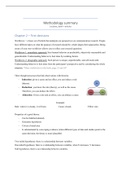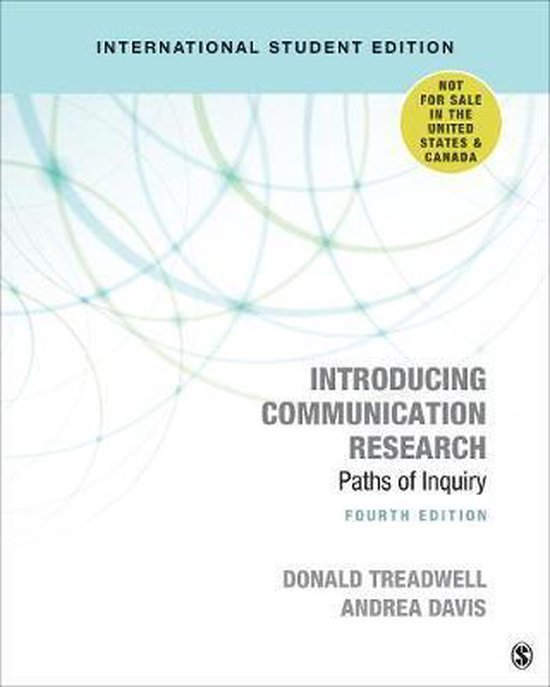Methodology summary
Lectures, book + articles
Chapter 2 – First decisions
Worldview = a basic set of beliefs that underpin our perspectives on communication research. People
have different takes on what the purpose of research should be, which shapes their approaches. Being
aware of your own worldview allows you to refine your research questions.
Worldview 1: nomothetic approach: Sees human behavior as predictable, objectively measurable and
generalizable. Understanding behavior is best done by isolating factors.
Worldview 2: idiographic approach: Each person is unique, unpredictable, and self-motivated.
Understanding behavior is best done from the participant’s perspective and by considering the whole
situation. *More worldviews in the book, page 25 and 26*
Three thought processes that link observations with theories:
- Induction: given a cause and an effect, you can induce a rule
(theory).
- Deduction: you know the rule (theory), as well as the cause.
Therefore, you can deduce the effect.
- Abduction: Given a rule and an effect, you can abduce a cause.
Example:
Rule: when it is cloudy, it will rain. Cause: clouds Effect: rain
Properties of a good theory:
- Can be falsified (denied)
- Generates hypotheses
- Covers a broad area
- Is substantiated by converging evidence (when different types of data and studies point in the
same direction, the theory is more plausible)
Two-tailed hypotheses: there is a relationship between variables.
One-tailed hypotheses: there is a relationship between variables, when X increases, Y decreases.
Null hypotheses: there is no relationship between variables.
,Triangulation: the act of combining research methods to neutralize the weaknesses of single research
methods.
The effect of an IV on a DB may depend on the level of a moderating variable (which is often not
manipulated). When there is mediation, the effect of IV on DV is indirect; the IV has an effect on the
mediating variable, which in turn has an effect on the DV (e.g. Spelling errors à Perception of
intelligence (mediating variable) à attractiveness and dating intention). Mediation may be partial or
full. When the effect of one IV on the DV depends on the level of the other IV, there is an interaction
effect. A third variable explains the apparent correlation (or causation) between IV and DV, because
the third variable actually causes changes in both variables (e.g. there is a positive correlation between
amount of ice cream sold and number of murders per week, the third variable could be temperature.
The heat drives both ice cream consumption and interpersonal conflict). Confounding variables are
variables that co-vary with the levels of your IV (similar circumstances).
Method decisions are rooted in epistemology (how we know what we know). Ways of understanding
communication include tenacity (we’ve always done it or understood it that way), intuition (gut
instinct), authority (a credible source said so), rationalism (logical reasoning) and empiricism
(observation). The general purposes of research are description, explanation, prediction, control,
interpretation and criticism.
Chapter 3 - Ethics
Ethics = the study of right ang wrong, responsibility, and appropriate behavior toward research
participants. Communication research ethics share with medical and psychological ethics a basic
concern to protect the well-being of human participants.
Confederates = participants who have been briefed to behave in a particular way; they are ‘faking it’
and deceiving the speaker.
Unobtrusive measure = an approach that by definition observes people’s behavior without their
being aware of it (e.g. not asking people if they wear seatbelts but checking by observing).
Ethics issues in communication research
- Honesty
o The deception in some research designs is allowed, as long as the participants are
made aware of the deception immediately after the study is concluded à debriefing.
o Researchers have the responsibility to their readers to report results honestly.
o Open disclosure of a researcher’s relationships to funding agencies.
- Confidentiality and anonymity
, o Confidentiality: the researcher will not release any information that identifies the
participants, even if the researcher knows what information each participant provided.
o Anonymity: the data that is collected does not identify the participants at all, not even
the researcher knows (e.g. by not asking their name, in face-to-face interviews
anonymity is not an option).
o 3 types of data:
§ Standard data contains no personal data.
§ Confidential data contains (direct or indirect) personal information or other
sensitive information.
§ Secret data contains special categories of highly personal data or
information of companies (racial origin, political opinion, medical data,
financial information). How to protect confidential and secret data:
anonymization, pseudonymization (separating identifying data from non-
identifying data), encryption (data can only be read with a password).
- Making generalizations
o Research participants have to be volunteers. If only willing volunteers are recruited to
your study, you will be recruiting individuals who have a bias toward your study in
the sense that they are willing to participate in them. Therefore, you can only make
generalization from these types of individuals.
- Debriefing
o If your participants have been exposed to deception, you have an ethical obligation
after the study is over to explain the deception and invite any follow-up questions.
- Literature review
o Proprietary information = information that is owned, typically by corporations and
may not be published without the owner’s permission.
- Acknowledging others: taking responsibility for the project reported.
- Appropriate language: consent documents need to be written in the language best understood
by the participant.
- Plagiarism: fraud.
- Peer review: qualified researchers with similar interests assessing each other’s work (e.g. the
IRB (institutional review board), a panel established to review research proposals specifically
for their impact on human participants, the ethics).
Chapter 4 – Literature review & systematic reviews
Literature review = contextualizes the research question and study presented in that particular text.





